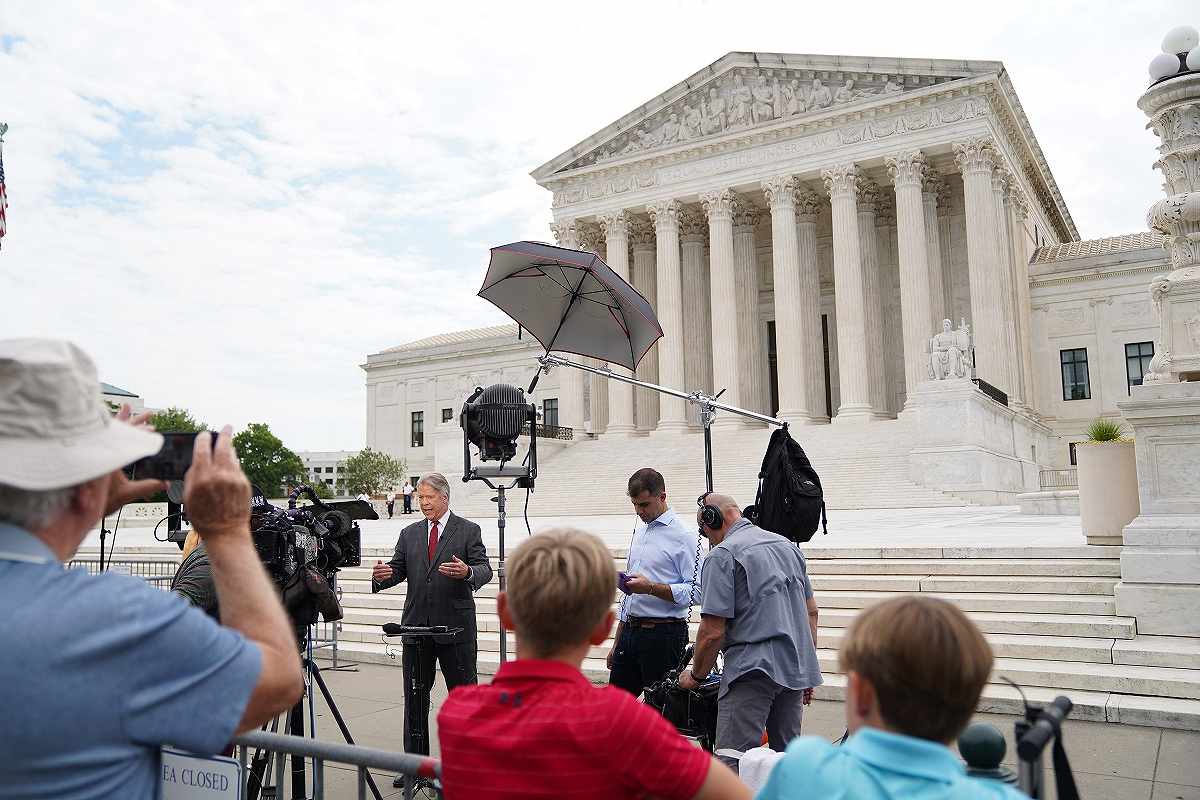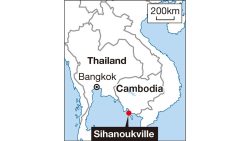Supreme Court Rejects Theory That Would Have Meant Radical Changes to Election Rules

A news crew outside the Supreme Court in Washington, D.C., on June 27, 2023.
17:12 JST, June 28, 2023
The Supreme Court on Tuesday rejected what would have been a radical change in election law, dismissing the theory that state legislatures have almost unlimited power to decide the rules for federal elections and draw partisan congressional maps without interference from state courts.
The Constitution’s elections clause “does not insulate state legislatures from the ordinary exercise of state judicial review,” Chief Justice John G. Roberts Jr. wrote in a 6-3 decision.
The decision was praised by Democrats and civil rights groups, more for firmly rebuffing what they viewed as an outlandish theory than for establishing new law. A wide coalition of scholars, liberal lawyers and conservative former judges had denounced the theory as unmoored and extreme.
Maintaining the status quo is seen as significant for a court that in recent years has constricted voting and election protections in federal law and the Constitution.
In a separate decision earlier this month, however, the court relied on its previous interpretations of the Voting Rights Act to find the Alabama legislature drew congressional districts that unlawfully diluted the political power of its Black residents. After Tuesday’s decision, voting rights advocates and Democrats said the combined opinions give them hope of being able to successfully challenge some Republican-led redistricting efforts.
At the White House, deputy press secretary Olivia Dalton said, “We’re pleased that the Supreme Court rejected the extreme legal theory presented in this case, which would have interfered with state governments, which would have opened the door for politicians to undermine the will of the people and would have threatened the freedom of all Americans to have their voices heard at the ballot box.”
Some legal experts said Tuesday’s decision gives federal courts, including the Supreme Court, a bigger role to play in second-guessing state actions on election law, with few guidelines.
“We are going to see constant litigation around this issue in the 2024 elections until courts provide a more clear sense of the boundaries on state court decision-making,” said Richard H. Pildes, a law professor at New York University.
The case at hand came from North Carolina, whose Republican legislative leaders advanced the theory that the Constitution assigns state legislatures almost exclusive authority to structure federal election rules, subject only to intervention by Congress.
The “independent state legislature theory” holds that is the case even if legislative decisions result in extreme partisan voting maps for congressional seats and violate voter protections enshrined in state constitutions.
But six members of the court said the theory is wrong.
“The legislature acts both as a lawmaking body created and bound by its state constitution, and as the entity assigned particular authority by the Federal Constitution,” Roberts wrote. “Both constitutions restrain the legislature’s exercise of power.” He was joined by an ideologically mixed group of justices: Sonia Sotomayor, Elena Kagan, Brett M. Kavanaugh, Amy Coney Barrett and Ketanji Brown Jackson.
Roberts included an important caveat, however, one that could give federal courts an enhanced role in overseeing decisions made by state courts on election-related matters.
“Although we conclude that the Elections Clause does not exempt state legislatures from the ordinary constraints imposed by state law, state courts do not have free rein,” he wrote. State courts, he added, “may not transgress the ordinary bounds of judicial review such that they arrogate to themselves the power vested in state legislatures to regulate federal elections.”
Federal courts will play a role in interpreting what Roberts meant by “transgress the ordinary bounds.” The opinion was candid in saying it was not adopting any test that would decide when state courts had gone too far. “The questions presented in this area are complex and context specific,” Roberts wrote.
Justices Clarence Thomas, Samuel A. Alito Jr. and Neil M. Gorsuch said the court should have dismissed the case instead of ruling on it, because recent action by the North Carolina Supreme Court made the original lawsuit moot. But Thomas and Gorsuch went beyond that, questioning the open-ended role Roberts’s ruling envisioned for federal courts.
“What are ‘the bounds of ordinary judicial review?'” Thomas asked in his dissent. “What methods of constitutional interpretation do they allow? Do those methods vary from State to State? . . . The majority’s framework would seem to require answers to all of these questions and more.”
Some liberal election law experts had similar concerns. “Make no mistake: this apparent new test would give great power to federal courts, and especially to the U.S. Supreme Court, to second guess state court rulings in the most sensitive of cases,” UCLA election law expert Richard Hasen wrote in Slate. “It is going to allow for a second bite at the apple potentially in cases involving the outcome of presidential elections.”
Others said that prediction was pessimistic. Neal K. Katyal, who argued the case for one set of plaintiffs at the Supreme Court, said he took Tuesday’s decision to mean there were six votes to resist attempts “to mess with the integrity of the 2024 election.”
The decision also appears to leave state courts free to monitor partisan gerrymandering, or not – a role for which the Supreme Court said federal courts lack authority. And the majority opinion seems to accept as established the court’s 2015 decision in Arizona State Legislature v. Arizona Independent Redistricting Commission, which said the elections clause did not bar a state’s voters from turning over redistricting decisions to an independent commission.
Only two of the five justices in the majority in that case are still on the court. Roberts wrote a slashing dissent.
If Tuesday’s ruling had gone the other way, the case could have had a major influence on the 2024 election. It has drawn attention in part because of the nation’s polarized politics, in which former president Donald Trump and his allies are still advocating to overturn the 2020 election, and the midterms showed yet again how much control of the U.S. House can depend on the drawing of congressional district lines.
“In its most extreme form, the Independent State Legislature Theory could have weakened the foundation of our democracy, removing a crucial check on state legislatures and making it easier for rogue legislators to enact policies that suppress voters and subvert elections without adequate oversight from state courts,” Abha Khanna, a lawyer who represented plaintiffs, said in a statement. “We are incredibly relieved that the Supreme Court decisively rejected this dangerous theory.”
The theory comes from a strict reading of the Constitution’s elections clause, which says: “The times, places and manner of holding elections for senators and representatives, shall be prescribed in each state by the legislature thereof.”
Proponents of the theory argue that the use of the term “legislature” means that only lawmakers may set election rules and draw congressional maps, and that governors, election administrators and even state courts enforcing state constitutions have no role to play. According to that argument, only Congress could step in to overrule the state legislators.
At oral arguments in the case in December, the three most conservative justices – Thomas, Alito and Gorsuch – appeared open to such a reading of the text. The three liberals – Sotomayor, Kagan and Jackson – were adamantly opposed. Roberts, Kavanaugh and Barrett seemed to think that state lawmakers deserved the predominant role but that there still was room for judicial oversight.
There was some thought that the court would dismiss without deciding the case, because of its convoluted history.
It started when population growth in North Carolina gave the state an additional congressional seat. North Carolina is a purple state, but the map created by Republican legislative leaders after the 2020 Census would have given the GOP an edge in 10 of 14 congressional districts.
An array of plaintiffs challenged the map. The elected state Supreme Court, then with a majority of Democratic justices, agreed.
The court concluded the maps “are unconstitutional beyond a reasonable doubt under the free elections clause, the equal protection clause, the free speech clause, and the freedom of assembly clause of the North Carolina Constitution.”
Under a new map imposed just for the 2022 election, the congressional delegation is split seven to seven.
But in last fall’s elections, the state Supreme Court became majority Republican. Those justices reconsidered the case and reversed their predecessors, giving lawmakers free rein to draw state legislative and congressional maps as they see fit. The majority said that there is “no judicially manageable standard by which to adjudicate partisan gerrymandering claims” and that “courts are not intended to meddle in policy matters.”
As a result, the congressional map for 2024 will be drawn by a legislature with a Republican supermajority, and reviewed by a Republican-majority state Supreme Court.
The case is Moore v. Harper.
"News Services" POPULAR ARTICLE
-

American Playwright Jeremy O. Harris Arrested in Japan on Alleged Drug Smuggling
-

Taiwan President Shows Support for Japan in China Dispute with Sushi Lunch
-

Japan’s Nikkei Stock Average as JGB Yields, Yen Rise on Rate-Hike Bets
-

Japan’s Nikkei Stock Average Licks Wounds after Selloff Sparked by BOJ Hike Bets (UPDATE 1)
-

Japanese Bond Yields Zoom, Stocks Slide as Rate Hike Looms
JN ACCESS RANKING
-

Keidanren Chairman Yoshinobu Tsutsui Visits Kashiwazaki-Kariwa Nuclear Power Plant; Inspects New Emergency Safety System
-

Imports of Rare Earths from China Facing Delays, May Be Caused by Deterioration of Japan-China Relations
-

Japan Exports Rise in October as Slump in U.S. Sales Eases
-

Govt Aims to Expand NISA Program Lineup, Abolish Age Restriction
-

Blanket Eel Trade Restrictions Rejected


























